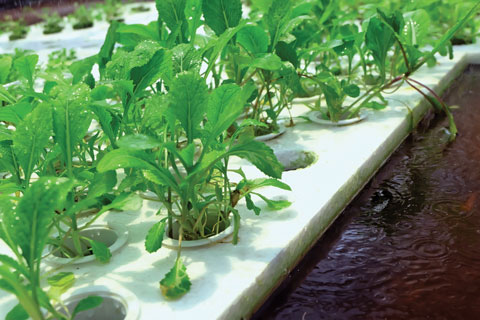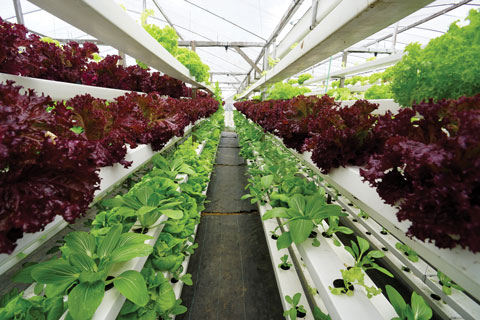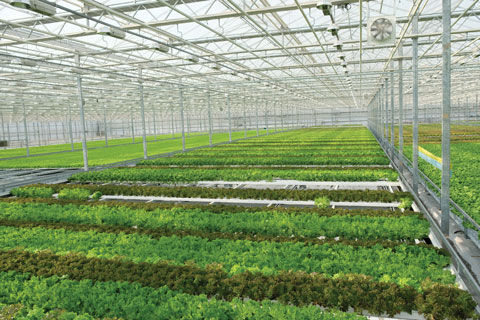6/1/2022
CEA: A Path to Sustainability?
Nathan Wallace-Springer

Over the last 250 years, human cultivation of plants has evolved from growing plants in simple agricultural systems, such as open-field farms, into highly sophisticated facilities where the entire plant production environment of a crop can be controlled. These newer systems, also referred to as Controlled Environment Agriculture (CEA), seek to offer sustainable, year-round food production through the reductions of inputs—like water, fertilizers and pesticides—to meet our population’s increasing food demand.
Pictured: A vertical farming CEA system used to grow leafy greens.
So what’s with the hype surrounding these new systems, how exactly do they work and, more importantly, are they really sustainable? Let’s find out!
What Is Controlled Environment Agriculture?
Controlled Environment Agriculture, or CEA, can be defined as the integration of engineering, chemistry, entomology and computer greenhouse control technologies with plant sciences to enhance plant production, quality and efficiency. Simply put, CEA systems incorporate modern technology with optimized horticultural practices to give growers the ability to manipulate plant production environments.
In these systems, complex variables such as light, temperature, humidity, carbon dioxide and nutrient availability are routinely monitored and adjusted to provide plants with optimum growing conditions. As a result, CEA systems can produce safe and healthy crops throughout the year at quicker intervals than conventional methods.
Types of CEA systems
There are three primary forms of CEA systems: 1) hydroponic, 2) aquaponic and 3) growing media-based systems.
In hydroponic CEA systems, an aqueous solution comprised of all essential nutrients needed for optimal plant growth is supplied to plants. Examples of hydroponic CEA include systems like large indoor vertical farming operations or high-tech greenhouses that utilize a hydroponic design, such as aeroponics, deep water culture (DWC) or nutrient film technique (NFT).
Conversely, in aquaponic CEA systems, fish production is integrated with plant production utilizing hydroponic system designs. However, instead of fertilizing plants with an aqueous solution comprised of all essential nutrients, plants are alternatively fertilized with nutrient-rich fish water that’s been filtered, converted to nitrates and supplemented for limiting nutrients deficient in aquaponic systems. Examples of aquaponic CEA systems include systems like high-tech indoor recirculating aquaponic systems (RAS) or decoupled aquaponic systems (DAPS).
 Pictured: An aquaponics CEA system.
Pictured: An aquaponics CEA system.
Lastly, in growing media-based CEA systems, plants are typically cultivated in a soilless growing media (e.g., peat moss, rockwool, coir, perlite, etc.) and then supplied a water-nutrient solution. Examples of this CEA system include high-tech greenhouses or facilities that utilize growing media to produce plants. Many PRO-MIX formulations are used and well-suited for this application.
Benefits of CEA
Consumer perspective: Consumers directly benefit from the use of CEA systems. For example, CEA systems can provide consumers with yearly access to fresh produce or plants with minimal quality loss that may otherwise be unavailable or unattainable in their region at times throughout the year. Moreover, because CEA systems aren’t bound geographically and technology can be used to supplement all plant processes, they have the potential to provide year-round production at just about any location. As a result, they can be utilized to supplement food production in areas that might need them the most, such as desert regions that receive little water to grow crops to polar regions that receive little light.
Grower perspective: Growers also directly benefit from CEA systems, as they can directly increase their revenue (e.g., through increased yield and efficiency) while also decreasing their costs (e.g., through decreased inputs and grow times), increasing profit. Moreover, because these systems give growers precise control over their growing conditions, problems that are found in conventional farming systems, such as pests and contaminations, are reduced. Furthermore, with current market trends showing that consumers are placing a higher emphasis on environmental sustainability than ever before, these systems offer new commercial marketing possibilities to growers that wouldn’t otherwise exist.
Environmental perspective: Lastly, CEA systems require less water, nutrient fertilizers (N, P, K, etc.) and pesticide inputs to grow the plants compared to their conventional agricultural counterparts. As a result, their usage can help conserve and prevent the waste of valuable resources that will be needed as the Earth’s population continues to grow. Moreover, because these systems aren’t restricted by geographical means, they can be located in areas where traditional agriculture isn’t possible, such as urban centers, which helps to further reduce their environmental impact.
Shortcomings of CEA?
While there are many positives associated with CEA systems, it’s important to caution that there can be drawbacks associated with them as well. For instance, these systems can be viewed as “high cost” and “high risk.” CEA systems typically have large, up-front costs associated with them to cover the machinery, as well as specialized labor needed to operate them. Moreover, they can be very energy-intensive and often require back-up systems be in place in case of power outages to avoid crop failures. Furthermore, they aren’t immune to waterborne diseases or pests, which once in a system, can quickly spread from plant to plant due to the interconnected nature.
As a result, not every system will be viable at every location and not every crop will be able to be grown profitably. It’s for these reasons that calculations should be done before upgrading or opening a facility to determine whether it’ll be cost-effective.
So … are CEA systems sustainable?
Unfortunately, the short answer to this question is … it depends on the context in which we’re analyzing the term “sustainable.” For instance, CEA is a broad term that encompasses a wide range of indoor and outdoor agriculture practices. If we interpret “sustainable” to mean “profitability,” that answer will greatly depend on the system design utilized, crop type selected and location the plants are being grown. However, since we know that not every system or crop will be profitable at any given location, the sustainability of a CEA system in this context will vary.
 Pictured: A growing media-based CEA system.
Pictured: A growing media-based CEA system.
Conversely, if we take “sustainable” to mean “better for the long-term environment,” then we should first begin by analyzing the impact that CEA systems have on agriculture production. Overall, plant-based production only accounts for a small proportion of the total greenhouse gas emissions from global agricultural production. However, not all this plant production is created equal. CEA systems are typically utilized for smaller vegetables, leafy greens and herbs due to their size constraints, which already have a low environmental impact, yet these aren’t the crops that feed the world—grains (e.g., wheat, corn and rice) grown in conventional agriculture systems are!
Therefore, while CEA systems can be more environmentally friendly than conventional agriculture systems when growing the same crop, CEA systems as they are being utilized now contribute very little overall reduction of greenhouse gases from agriculture. Additionally, it’s worth reiterating that most commercial CEA systems are still highly energy intensive, and in some cases, these systems can actually contribute more greenhouse gas emissions.
Nonetheless, as the world’s population continues to grow, increased food supply will be needed, which means our current way of farming must adapt and innovate to meet these demands. Therefore, while large-scale, commercial CEA systems may not be able to solve all of the world’s food problems, I believe they certainly have a potential to be a major part of the solution. IG
 Nathan Wallace-Springer is the newest member of the Grower Service team at Premier Tech. Nathan has a background in hydroponic and aquaponic greenhouse crops, LED lighting and plant nutrition with a Master of Science in Horticulture, a Bachelor of Arts in Environmental Science, and minors in Natural Resource and Environment Law and Environmental Horticulture. Visit www.pthorticulture.com/en/grower-services for more information.
Nathan Wallace-Springer is the newest member of the Grower Service team at Premier Tech. Nathan has a background in hydroponic and aquaponic greenhouse crops, LED lighting and plant nutrition with a Master of Science in Horticulture, a Bachelor of Arts in Environmental Science, and minors in Natural Resource and Environment Law and Environmental Horticulture. Visit www.pthorticulture.com/en/grower-services for more information.